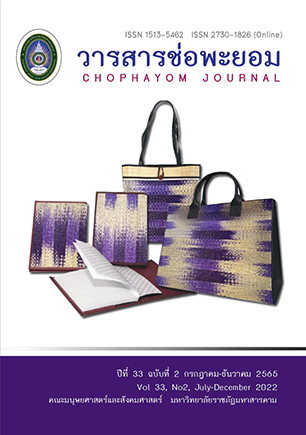Move Analysis of Print and Online Advertisements
Keywords:
genre analysis, move analysis, print advertisement, online advertisementAbstract
This study aimed to explore the moves used in print and online advertisements. The sample used in this study consisted of 45 print advertisements and 45 online advertisements. The purposes of this study were (i) to identify the moves used in both print and online advertisements and (ii) investigate the differences and similarities of both groups. Four obligatory moves were found in print advertisements: Headlines, Detailing the product or service, Soliciting response, and Brand name and Logo. The remaining moves were optional, except Using pressure tactics which was not found in the moves of print advertisements. Regarding online advertisements, the obligatory moves were Detailing the product or service, and Link button. Keywords: genre analysis, move analysis, print advertisement, online advertisement
References
Askehave, I., & Nielsen, A. E. (2005, January). What are the characteristics of digital genres?-Genre theory from a multi-modal perspective. In Proceedings of the 98a). IEEE. 38th Annual Hawaii International Conference on System Sciences (pp. 98a-
Bhatia, V. K. (1997). Genre-mixing in academic introductions. English for specific purposes, 16(3), 181-195.
Bhatia, V. (2002). Applied genre analysis: a multi-perspective model. Ibérica: Revista de la Asociación Europea de Lenguas para fines específicos (AELFE), (4), 3-19.
Bhatia, V. (2004). Worlds of written discourse: A genre-based view. London : Bloomsbury Publishing.
Bhatia, V. K. (2005). Generic patterns in promotional discourse. Persuasion across genres: A linguistic approach, 213-225.
Briones, R. L., Kuch, B., Liu, B. F., & Jin, Y. (2011). Keeping up with the digital age: How the American Red Cross uses social media to build relationships. Public relations review, 37(1), 37-43.
Chaidet, C., & Pupipat, A. (2021). Move Analysis of Women and Men’s Personal Care Product Online Advertisements. Journal of Studies in the English Language, 16(2), 22-51.
Charette, P., Hooker, N. H., & Stanton, J. L. (2015). Framing and naming: A process to define a novel food category. Food Quality and Preference, 40, 147-151.
Cook, G. (2001). The discourse of advertising. and edition. London : Routledge.
Crystal, D. (2012). English as a global language. Cambridge university press. Cambridge : Cambridge university.
Dayag, D. (2008). The Discourse of Print Advertising in the Philippines: Generic Structures and Linguistic Features. In PACLIC (pp. 1-15).
dos Santos, V. P. (2002). Genre analysis of business letters of negotiation. English for specific purposes, 21(2), 167-199.
Hashim, A. (2010). Print advertisements in Malaysia. World Englishes, 29(3), 378-393.
Hjarvard, S. (2004). The globalization of language. How the media contribute to the spread of English and the emergence of medialects. Nordicom Review, 25(1-2), 75-97.
Hyland, K. (2008). Genre and academic writing in the disciplines. Language Teaching, 41(4), 543-562.
Hyon, S. (1996). Genre in three traditions: Implications for ESL. TESOL quarterly, 30(4), 693-722.
_______. (2017). Introducing Genre and English for Specific Purposes. London : Routledye.
Janoschka, A. (2004). Web advertising: new forms of communication on the Internet (Vol. 131). John Benjamins Publishing.
Kanoksilapatham, B. (2005). Rhetorical structure of biochemistry research articles. English for specific purposes, 24(3), 269-292.
Karson, E. J., & Korgaonkar, P. K. (2001). An experimental investigation of Internet advertising and the elaboration likelihood model. Journal of current issues & research in advertising, 23(2), 53-72.
Kirkpatrick, A. (2011). English as an Asian lingua franca and the multilingual model of ELT. Language Teaching, 44(2), 212-224.
Krishnasamy, K. (2007). English in Tamil: the language of advertising. English Today, 23(3-4), 40-49
Labrador, B., Ramón, N., Alaiz-Moretón, H., & Sanjurjo-González, H. (2014). Rhetorical structure and persuasive language in the subgenre of online advertisements. English for specific purposes, 34, 38-47.
Liu, N., Yan, J., Fan, W., Yang, Q., & Chen, Z. (2009, April). Identifying vertical search intention of query through social tagging propagation. In Proceedings of the 18th international conference on World wide web (pp. 1209-1210).
Luo, J., & Huang, T. (2015). Genre-Based Analysis of American Tourism Brochure. Open Journal of Social Sciences, 3(09), 200.
Musté, P., Stuart, K., & Botella, A. (2015). Linguistic choice in a corpus of brand 350-358. slogans: repetition or variation. Procedia-Social and Behavioral Sciences, 198,
Nakajima, S. (2016). State of Online Advertising Worldwide. Digiworld Economic Journal, (104), 89-97.
Park, M., & Lennon, S. J. (2009). Brand name and promotion in online shopping contexts. Journal of Fashion Marketing and Management: An International Journal.
Sirbu, A. (2015). THE SIGNIFICANCE OF LANGUAGE AS A TOOL OF COMMUNICATION.
Scientific Bulletin" Mircea cel Batran" Naval Academy, 18(2), 405.
Skorinko, J. L., Kemmer, S., Hebl, M. R., & Lane, D. M. (2006). A rose by any other name…: Color-naming influences on decision making. Psychology & Marketing, 23(12), 975-993.
Statista. (2019a). Monthly reach of leading women's magazines in the United Kingdom (UK) from January 2018 to December 2018 (in 1,000 individuals). Retrieved from https://www.statista.com/statistics/246085/reach-of-selected-womensmagazines-in-the-uk/
Statista. (2019b). Monthly reach of selected men's magazines in the United Kingdom (UK) from January 2018 to December 2018 (in 1,000 individuals). Retrieved from https://www.statista.com/statistics/246096/reach-of-selected-mensmagazines-in-the-uk/
Swales, J. M. (1990). Genre analysis: English in academic and research settings. Cambridge University Press.
Tiggemann, M., & Miller, J. (2010). The Internet and adolescent girls’ weight satisfaction and drive for thinness. Sex roles, 63(1), 79-90.
Tiggemann, M., & Slater, A. (2014). NetTweens: The internet and body image concerns in preteenage girls. The Journal of Early Adolescence, 34(5), 606-620.
Yong, L. Y., & Mei, C. C. Y. (2018). A Genre and Multimodal Analysis of Milk Formula Advertisements in a Local Parenting Magazine. LSP International Journal, 5(2).
Downloads
Published
How to Cite
Issue
Section
License
Copyright (c) 2022 Chophayom Journal

This work is licensed under a Creative Commons Attribution-NonCommercial-NoDerivatives 4.0 International License.






